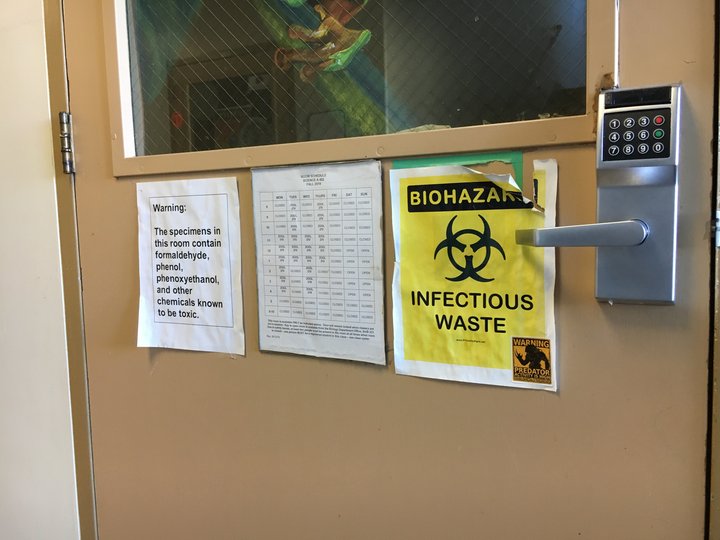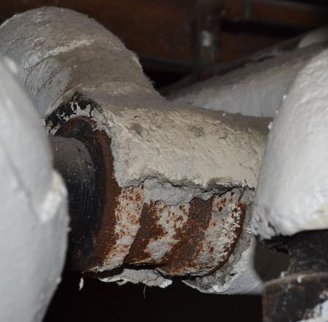
A hazmat sign warns students that the anatomy lab contains formaldehyde. Photo: Freddy Brewster.
###
The results of a campus-wide audit of 17 different observation sites found a number of problems with how Humboldt State manages and communicates when it comes to health and safety risks.
The six-week long audit took place during April and May. It was part of a system-wide internal auditing process for the California State University system, and was prompted after an audit published in 2018 found that four universities — two small and two large — did not meet the required levels of oversight when it came to protecting students, staff and faculty from hazardous waste.
The HSU audit found many examples of where the “communication of key roles and responsibilities needed improvement,” and that the campus does not have “an effective monitoring process to ensure that responsibilities were performed.” The audit went on to say that the university needs to improve how often the heating, ventilation and air conditioning systems are checked, and that the university “did not always ensure that HAZMAT inventories were maintained.”
On Monday, a campus-wide email went out to remind the campus community that proper labeling and storing of hazardous materials is a requirement as well as the importance of the matter. Sabrina Zink, an Environmental Health and Safety specialist for HSU, said the purpose of the email was to get the attention of those involved with the generation and storage of hazardous materials and for them to become aware of their shortcomings.
“Once you generate waste and if it has hazardous characteristics, you have to dispose of it according to the regulations,” Zink said, “and because HSU has an EPA ID, we are held at a much higher standard. Not many things can be thrown in the trash here.”
Zink said a lot of the hazardous waste is generated from science labs and facilities management in the form of paints and other building materials. Move-out days also are a large producer of hazardous waste, Zink said. Cleaning products and over-the-counter drugs are often left behind in such high volumes that they cannot be simply thrown away.
“If you think about HSU as a small city, there is a lot of different activity going on and the obvious byproduct of a lot of those activities is hazardous waste,” Zink said.
The HSU audit focused on a wide range of topics that includes injury and illness prevention; student health and safety training; medical monitoring; laser safety; and the storage of and access to hazardous materials.
When it comes to hazardous and universal waste at the university, the audit looked at many locations spread throughout the campus. At four of the locations containers were not labeled with the correct start date for the accumulation of waste — two locations lacked proper identification of the contents, and two locations had material accumulating past the recommended time period.
Zink chalked up some of these mishaps to administration-type issues like the mislabeling of dates and content. She said one professor brought a container to a storage room manager and they didn’t get to labeling it before the inspector saw the container. Zink said this incident happened during the end of the spring semester when the labs were being cleaned out.
The Outpost also chatted with Zink about the recent reports of asbestos in Gist and Siemens Halls. She said that many of the buildings at HSU are older, and constructed when asbestos was a commonly used building material.
“Any building that is old, prior to 1981, is assumed to have asbestos,” Zink said. “In newer buildings you can’t assume that it is not being used because it is not banned in the United States.”

Pipe insulation containing asbestos. Photo: EPA.
Contrary to popular belief, asbestos is not outright banned in the United States. In 1989, there was a partial ban issued for asbestos that included banning it from being used in corrugated paper, flooring felt and “new commercial uses that begin after August 25, 1989.” An update to this ban came in April that banned asbestos in adhesives, sealants, cement products and missile liners.
Routine exposure to asbestos — a naturally occurring mineral — can cause lung cancer, mesothelioma, asbestosis and other respiratory-related illnesses. It takes a long time for symptoms related to asbestos exposure to appear — anywhere from 10 to 70 years — and those most at risk are usually construction and automotive workers.
“The idea is that it was more common in most building products back then and now the market has gone away from using asbestos in most products,” Zink said. “If you keep it contained then it can’t escape, but if it gets in the air that is when it becomes a problem.”
The May closure of Gist Hall was prompted out of an abundance of caution. Around that time, the building was having issues with the airflow throughout the building and a maintenance worker took off a floor vent and crawled into a small enclosure between two walls. The worker saw a chunk of what appeared to be white debris on the ground that was suspected to have fallen off of a pipe. Zink said that given the age of the building and the materials used to build it, the worker called his supervisor and the building was shut down that same day.
Just last week, asbestos was presumed to be found in Classroom 110 in Siemens Hall when a custodian popped loose a few tiles while waxing the floor. The classroom was closed off — as well as the HVAC system — and the tiles are being replaced in the room.
“Because of our experience with Gist Hall,” Zink said, “we’ve recommended that given the antiquity of Humboldt State we are going to take the initiative to investigate other older buildings so that we can address any potential concerns people have about the buildings they are working in.”
CLICK TO MANAGE